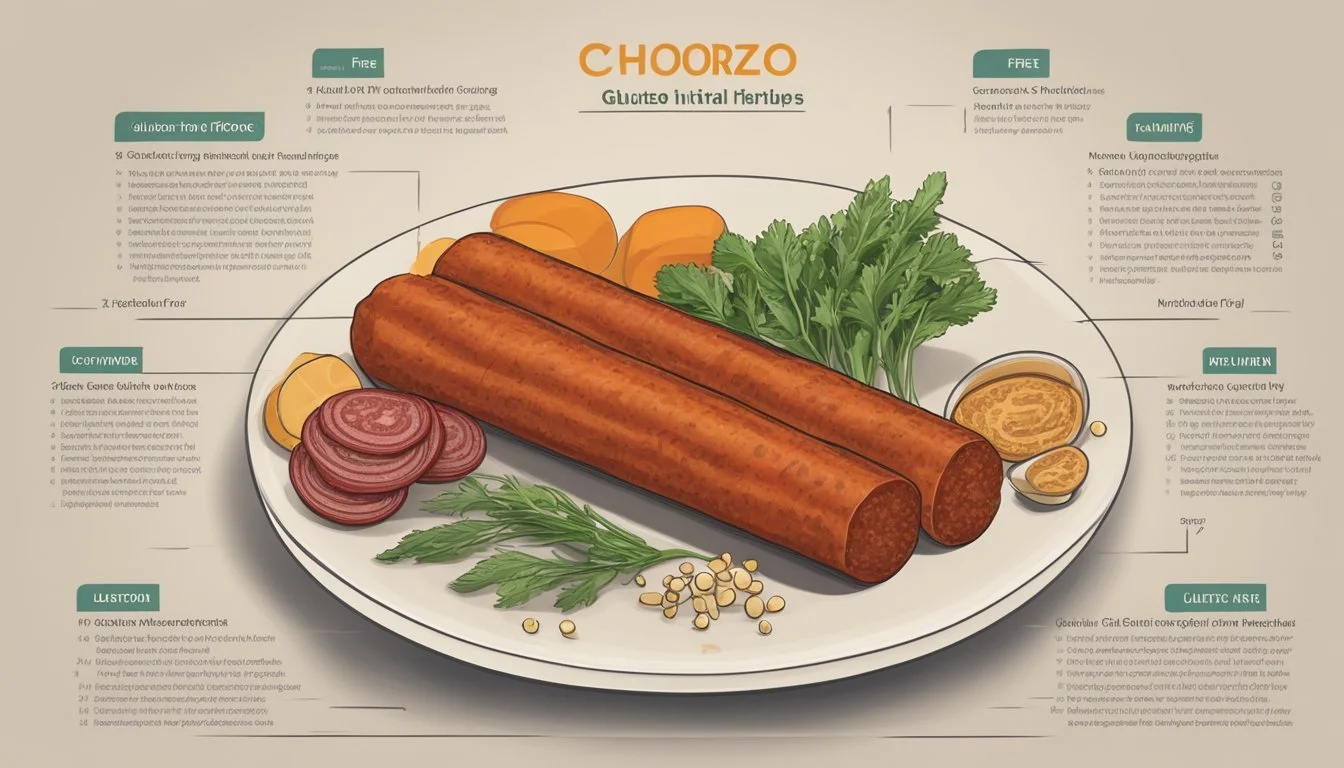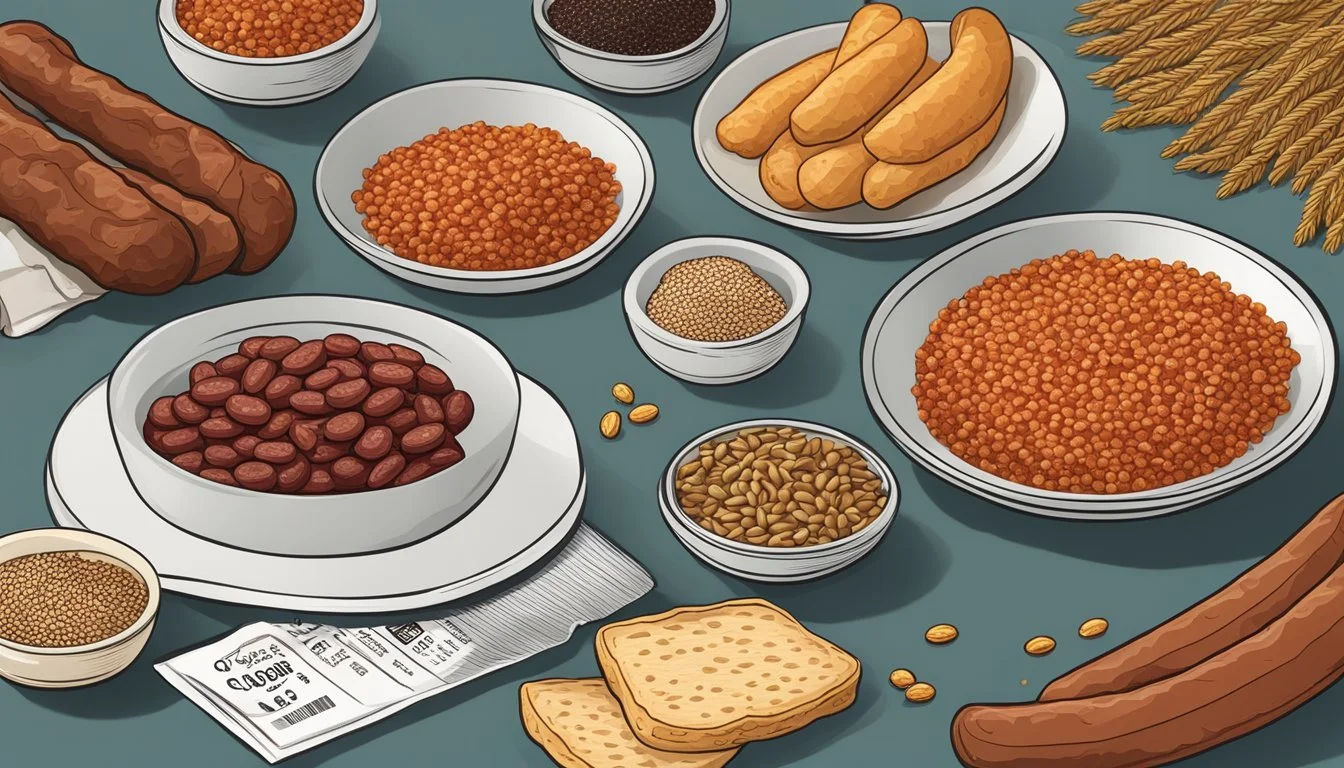Is Chorizo Gluten-Free?
Understanding Meat Products and Celiac Concerns
When considering whether chorizo, the spicy and robust sausage known for its deep red color and rich flavor, is suitable for a gluten-free diet, one must look to its ingredients and preparation methods. Traditionally made from pork, chorizo is seasoned with a variety of spices, including smoked paprika, which contributes to its distinctive flavor profile. The primary concern for gluten content arises from the potential use of fillers or additives that contain gluten in commercially produced chorizo.
For individuals with gluten sensitivities or celiac disease, identifying gluten-free options is essential. Some chorizos are indeed gluten-free, made without any wheat-based ingredients, binders, or fillers. Others may use non-gluten grains as alternatives. However, one must remain vigilant, as certain brands could include gluten-containing components or be subject to cross-contamination if produced on shared equipment with gluten-containing items.
Given the variations in production practices, it is advantageous for consumers to seek out chorizo products labeled as "gluten-free" or "certified gluten-free." This labeling indicates compliance with stringent gluten-free standards. Furthermore, transparent ingredient lists and good manufacturing practices serve as additional reassurances for those avoiding gluten in their diets.
Overview of Chorizo
Chorizo is a type of sausage that has its origins in Spain and Portugal. Traditionally, it is made from coarsely ground pork, though beef or a combination of both can also be used. These meats are seasoned with various spices, such as smoked paprika, which gives chorizo its characteristic deep red color and spicy flavor profile.
The sausage is versatile and features prominently in a variety of dishes. In Spain, chorizo is often served as part of tapas (What wine goes well with tapas?), small dishes that are shared at the beginning of a meal. It also plays a central role in stews, imbuing the dish with its distinct and robust flavor. The cooking method can vary; chorizo may be fried, grilled, or simmered, and it can be a key ingredient in both simple and complex recipes.
When considering gluten content, chorizo's primary ingredients (meat and spices) are naturally gluten-free. However, gluten may be present in chorizo due to additives or fillers used during the manufacturing process. Cross-contamination can also be a concern, particularly in facilities that process products containing gluten.
For individuals with gluten sensitivities or celiac disease, it is crucial to check product labels or inquire with manufacturers to confirm the absence of gluten. Some brands specifically cater to gluten-free diets, creating chorizo with a guarantee of no gluten-containing ingredients and safe processing practices.
Ingredients in Chorizo
Chorizo is a type of sausage with a distinctive blend of ingredients that give it its characteristic flavor. Its composition can vary, but typically includes a combination of meats and a robust array of seasonings.
Primary Ingredients
The primary ingredients in chorizo typically include:
Meat: Traditionally, chorizo is made with either pork, beef, or a mixture of both. The meat is finely ground and serves as the protein base of the sausage.
Fat: A certain amount of fat is included for flavor and texture.
Garlic: This adds a pungent flavor to the sausage.
Paprika: The quintessential spice that gives chorizo its bold color and smoky taste.
Additional Spices: A variety of other spices may be included, such as chili peppers, oregano, and cumin, to enhance the flavor profile.
Common Additives and Fillers
Chorizo may sometimes contain additives and fillers to enhance flavor, preserve freshness, or add bulk. These may include:
Salt: A traditional preservative used to cure the meat.
Vinegar: Often used in the curing process to add tartness and aid in preservation.
Grains: Some chorizo varieties might contain grains like wheat, barley, rye, or oats as fillers or extenders, which are important considerations for those avoiding gluten.
Additives: Certain brands may add sugars like dextrose and preservatives such as nitrites or nitrates (some may be naturally occurring in ingredients like celery powder).
Consumers with dietary restrictions, including those on a gluten-free diet, should carefully check labels as some chorizo might contain gluten, either from grains used as fillers or from cross-contamination during processing.
Chorizo and Gluten
In the context of gluten-related dietary needs, discerning whether chorizo is gluten-free is essential for individuals with gluten intolerance or celiac disease. The gluten content in chorizo can vary depending on the ingredients and processing methods used by manufacturers.
Risk of Gluten Presence
Cross-Contamination: Chorizo is a type of sausage that can be subject to cross-contamination with gluten during manufacturing. This is particularly a risk if the facility also processes foods containing wheat, barley, or rye. For individuals with celiac disease, even minor traces of gluten can cause health issues, making it crucial to choose products processed in a gluten-free facility.
Ingredient Label: Not all chorizo is created equal in terms of gluten content. Some versions may contain gluten depending on their ingredients which might include fillers or binders derived from wheat. Reading the product labels carefully is important to identify if wheat or other gluten-containing ingredients are listed.
Identifying Gluten-Free Chorizo
Gluten-Free Certification: Products labeled with a certified gluten-free mark have met strict guidelines ensuring that they contain less than 20 parts per million of gluten, the threshold determined safe by health authorities for most individuals with gluten intolerance.
Gluten-Free Ingredients: When selecting chorizo, checking for a clear 'gluten-free' label as well as the absence of gluten-containing ingredients ensures that the product is safe. Gluten-free chorizo should only include meats, spices, and binders that do not come from gluten sources. Ingredients like rice flour or cornstarch are commonly used as gluten-free alternatives in sausage production.
Gluten-Free Chorizo Alternatives
For individuals with gluten sensitivities or those adhering to a gluten-free diet, finding suitable alternatives to traditional chorizo is important for maintaining their health. Gluten-free chorizo alternatives are derived from various protein sources and do not contain gluten-containing ingredients often used in conventional chorizo recipes.
Plant-Based Proteins:
They who seek meatless options can opt for plant-based chorizo made from:
Soy
Tofu
Other vegetable proteins
These plant-based alternatives replicate the texture and flavor of traditional chorizo while catering to dietary needs.
Meat-Based Gluten-Free Options:
For those preferring meat but requiring a gluten-free option, there are selections such as:
100% grass-fed beef chorizo
Turkey chorizo
These chorizo variants avoid fillers and gluten-containing additives.
Ingredients to Avoid Gluten-Free Ingredients Wheat-based binders Celery powder Barley Sea salt Rye Non-Gluten grains (e.g. Rice)
When preparing homemade gluten-free chorizo, one has the control to ensure all ingredients meet their dietary needs. Homemade recipes allow adjustment of spice levels and the exclusion of unwanted additives.
Consumers should still exercise caution and review all product labels to ensure they are certified gluten-free. This is crucial as cross-contamination can occur during manufacturing.
Nutritional Profile of Chorizo
Chorizo, a type of sausage, has a distinctive spicy flavor and is often used to enhance the taste of various dishes. Understanding its nutritional makeup can help one gauge how it fits into their diet.
Macronutrients in Chorizo
Chorizo is a rich source of protein and contains a significant amount of total fat, including saturated fat. It also comes with a notable calorie count. Here is a breakdown of the key macronutrients:
Calories: Varies by type, but roughly 300-400 calories per 100g serving.
Protein: About 21-25g per 100g.
Total Fat: Approximately 25-30g per 100g.
Saturated Fat: Around 10-12g per 100g.
Cholesterol: Chorizo can contain significant cholesterol levels, often hovering around 70-90mg per 100g.
Sodium: It is also typically high in sodium, sometimes reaching over 1000mg per 100g.
Vitamins and Minerals
Chorizo provides certain vitamins and minerals, although they may vary based on the ingredients used:
Vitamins: It generally offers some B-vitamins, particularly Vitamin B12 and niacin.
Minerals: Minerals such as iron, zinc, and phosphorus can be found in chorizo.
For those managing their diet, it is essential to consider chorizo's rich flavor alongside its nutritional profile.
Preparing and Cooking Chorizo
When preparing and cooking chorizo, one must consider both the techniques used and the adaptations necessary for a gluten-free diet. These aspects ensure that the chorizo retains its flavorful characteristics while being safe for individuals with gluten sensitivities.
Cooking Techniques
Pan Frying: For crispy, golden-brown chorizo, pan-frying is ideal. Chorizo should be cooked in a hot pan until it's thoroughly browned and cooked through, usually taking about 12 minutes, often with added water to begin and frequent turning.
Baking: Placing chorizo in the oven at around 375°F for 20-25 minutes can yield a well-cooked sausage with a robust flavor. Ensure it's turned halfway through for even cooking.
Grilling: For those who prefer smoky undertones, cooking chorizo on the grill over medium heat permits the sausages to attain a charred exterior while staying juicy inside.
Gluten-Free Recipe Adaptations
Tacos and Burritos: Utilize gluten-free corn tortillas as a base for tacos or burritos; add cooked chorizo, rice, cheese, and any other desired toppings for a complete gluten-free meal.
Soups: Chorizo can add depth to gluten-free soups. Ensure that all other ingredients like broth and seasoning are also gluten-free.
Substitutions in Recipes: Replace bread crumbs or other gluten-containing binders with gluten-free alternatives like rice or potato-based breadcrumbs when making chorizo-based dishes such as meatballs.
By following these techniques and modifications, one can enjoy a variety of delicious, gluten-free chorizo dishes.
Understanding Food Labels
When selecting gluten-free chorizo, the importance of closely examining food labels cannot be overstressed. They offer crucial information regarding ingredients and potential gluten presence. Consumers should be vigilant about reading the labels to avoid gluten-containing products and gluten contamination.
Reading Ingredient Labels
The ingredient label on a product provides a list of all ingredients used in the manufacture of the food item. To determine if chorizo or any food product is gluten-free, one must meticulously inspect the ingredient list for any gluten-containing substances. These may include:
Wheat (including derivatives like wheatberries, durum, semolina, spelt, farina, farro, graham, and einkorn wheat)
Rye
Barley (including malt in various forms)
Triticale
Ingredients often hidden as sources of gluten include:
Modified food starch (when derived from wheat)
Maltodextrin (when derived from wheat)
Hydrolyzed vegetable protein (unless made from corn or soy)
Beyond direct ingredients, the label also may contain allergy warnings such as "made in a facility that also processes wheat," which suggests potential for gluten contamination even if the product ingredients are gluten-free.
Labels and Gluten-Free Certification
To instill confidence in consumers, many products will carry a certified gluten-free label. This certification means that the product has undergone testing and meets strict criteria for gluten content. Key points to look for regarding certification and gluten management include:
Certified Gluten-Free: This mark signifies that the product has been tested by a third-party organization and contains less than 20 parts per million (ppm) of gluten, which is the accepted threshold for being labeled as gluten-free.
Gluten-Free Claim: Some products might state "gluten-free" without an official certification. These claims are also regulated by the FDA and must comply with the same less than 20 ppm of gluten standard.
If shopping in the United States, products carrying either the certified gluten-free seal or making a gluten-free claim must adhere to the Food and Drug Administration (FDA) regulations for gluten labeling. When in a gluten-free aisle, these certifications provide a higher level of trust in the gluten-free status of the products. However, consumers should still read the ingredient labels for confirmation.
Living Gluten-Free
Adhering to a gluten-free diet is paramount for individuals with celiac disease or gluten sensitivities. Understanding the intricacies of this diet and navigating the food landscape are crucial for maintaining a healthy and symptom-free lifestyle.
Gluten-Free Diet Considerations
When selecting foods that comply with gluten-free dietary needs, it's important to look for items that are certified gluten-free. This certification ensures that there is no cross-contamination with gluten-containing products during the manufacturing process. Individuals with celiac disease or gluten sensitivities must avoid wheat, barley, rye, and derivatives of these grains. Here are some safe food options for a gluten-free diet:
Fruits and Vegetables: Naturally gluten-free and essential for a balanced diet.
Meat and Fish: Unprocessed and without additives or marinades that may contain gluten.
Dairy: Pure dairy products, as long as no gluten-containing thickeners are used.
Grains: Rice, quinoa, corn, tapioca, and gluten-free oats.
It's also essential to read labels meticulously, as gluten can be hidden in preservatives and additives.
Shopping and Dining Out Tips
Shopping for Gluten-Free Products:
Check labels for gluten-free certifications or the mention of gluten-containing ingredients.
Be vigilant about potential cross-contamination with gluten in bulk bins or deli counters.
Research restaurants in advance to find those offering gluten-free menus or accommodating dietary needs.
Communicate clearly with waitstaff about the severity of gluten intolerance to ensure food safety.
With these mindful practices, shopping and dining out can be a stress-free experience for those maintaining a gluten-free lifestyle.
Potential Health Concerns
When considering the consumption of chorizo for individuals with gluten intolerance or celiac disease, it is crucial to be vigilant about the ingredients. Gluten, found in wheat, barley, and rye, can cause serious adverse reactions in these individuals. Symptoms of gluten exposure can range from digestive issues to systemic responses like fatigue and joint pain.
Most traditional Spanish chorizo is made from simple ingredients such as ground pork, paprika, garlic, and salt, and does not typically contain gluten. However, variations exist, and some manufactures might use fillers or additives that are not gluten-free. These could include:
Wheat flour
Dextrin
Malt flavoring
For those concerned with maintaining a healthy diet, it's worth noting that chorizo can be calorically dense and contain high levels of fats and sodium. Here is a breakdown of considerations for healthy consumption:
Consideration Recommendation Gluten Content Check labels for gluten-free certification. Additives Look out for fillers or flavor enhancers with gluten. Caloric and Fat Content Consume chorizo in moderation as part of a balanced diet.
Certification and labeling are essential. Search for products with clear "gluten-free" labels. Those with gluten sensitivity should avoid products lacking such labeling or with ingredients indicating potential gluten content. Moreover, one may contact manufacturers directly to confirm their processing and cross-contamination prevention measures.
In conclusion, while many forms of chorizo are inherently gluten-free, the potential for gluten-containing additives or cross-contamination means that consumers must exercise caution, particularly if they have health concerns related to gluten.








